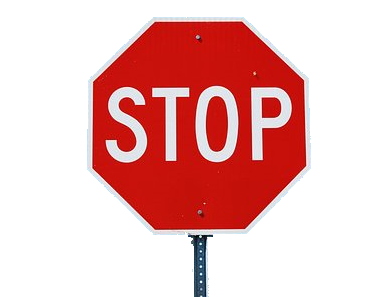
DANGERS > INTERSECTION > STOP SIGN
Stop Sign
☠️ Alert:
? Questions:
🛈 Information:

1 Way
4 Way
All things equal, whoever arrives at a stop sign first, is the one to go first. It is best that cars facing each other, go simultaneously, as opposed to cars on the left or right of each other. Alternate, to let each adjacent side go first.
☠️ Dangers related to stop signs
Failure to stop: One of the most significant dangers at stop signs is drivers who fail to come to a complete stop. Rolling through a stop sign or not stopping at all can cause collisions with other vehicles, pedestrians, or bicyclists who have the right-of-way. Blind spots: Stop signs may be located at intersections where visibility is limited due to parked cars, buildings, or other obstructions. Drivers must be cautious when approaching stop signs and ensure they have a clear view of the intersection before proceeding. Right-of-way confusion: Some drivers may be unsure of who has the right-of-way at a four-way stop, leading to confusion and accidents. Speeding: Drivers who are in a hurry or not paying attention may speed through stop signs, increasing the risk of collisions and accidents. Pedestrian safety: Pedestrians may also be at risk when approaching or crossing intersections with stop signs. Drivers must be aware of pedestrian traffic and give them the right-of-way when necessary.
? How many sides does a stop sign have?
Increased visibility: The distinctive shape of the octagon stands out among other road signs. The eight sides create a distinct outline that is easily recognizable, even from a distance. This helps drivers identify the sign and understand the need to stop, promoting road safety. Standardization and recognition: Stop signs are standardized across many countries to ensure consistency and universal recognition. The octagonal shape has become widely associated with the command to stop, making it easier for drivers to interpret and respond to the sign regardless of their location. Differentiation from other sign shapes: By having a unique shape, stop signs are visually distinguishable from other common road signs that have different shapes, such as triangular yield signs, rectangular regulatory signs, or circular warning signs. This differentiation helps drivers quickly and accurately identify the type of sign and its associated meaning. Historical reasons: The adoption of the octagonal shape for stop signs can be traced back to early traffic sign designs. The shape was chosen to make stop signs stand out and be easily recognizable during the early development of standardized traffic control devices.
? W hen all drivers arrive at a four way stop at the same time who has the right of way ?
Driver to the Right : Yield to the driver on your right. This rule applies to all drivers at the intersection. Straight and Turning : If two drivers are directly across from each other and one is turning while the other is going straight, the driver going straight has the right of way.
🛈 Stop sign vs yield sign
Stop Sign : A stop sign is a red, octagonal sign with the word "STOP" written in white letters. It indicates that a driver must come to a complete stop at the marked intersection, yield to all other traffic and pedestrians, and proceed only when it is safe to do so. Stop signs are typically placed at intersections where there is a higher risk of accidents or where visibility is limited. Yield Sign : A yield sign is a triangular sign with a white background and a red border. Inside the triangle, there is a white downward-pointing arrow. It indicates that a driver must slow down and yield the right-of-way to other traffic or pedestrians. However, the driver is not required to come to a complete stop unless necessary to avoid a collision. Yield signs are usually placed where merging or entering traffic must give way to the flow of traffic on the main roadway, such as at freeway ramps or where lanes merge.
🛈 Where to stop at stop sign
🛈 Parking near stop sign
Distance Requirement : In many places, there is a minimum distance requirement for parking near a stop sign. This distance is typically specified in local traffic ordinances and may vary, but it's often within a certain number of feet from the stop sign. For example, parking within 30 feet of a stop sign might be prohibited. Visibility : Parking near a stop sign should not obstruct the visibility of the sign for approaching drivers or pedestrians. Vehicles parked too close to a stop sign could block the view of the sign, making it difficult for other road users to see and respond appropriately. Intersection Clearance : Parking near a stop sign should not obstruct the intersection or interfere with the movement of vehicles turning at the intersection. Parking too close to a stop sign can impede the flow of traffic and create hazards for other drivers. Markings and Signs : Some jurisdictions may install additional signs or markings to indicate where parking is prohibited near stop signs. These signs might specify the distance within which parking is not allowed or simply indicate that parking is prohibited near the stop sign.